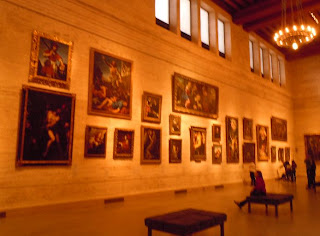I arrived at the museum at 11:00 and met several Meetup friends from past gatherings and outings. I could tell it was going to be a busy day. Once organized we went about our way enjoying the variety of the galleries new and old.
Actually the group I was with went ahead and I found myself at the information desk where I became a member of the MFA, now I can go back anytime for free! It looks like I'll have to go back often considering the over 450,000 works of art !
The museum was founded in 1870 and its current location dates to 1909. In addition to its curatorial undertakings, the museum is affiliated with an academy, the School of the Museum of Fine Arts, and a sister museum, the Nagoya/Boston Museum of Fine Arts, in Nagoya, Japan.
See what interesting information you can learn at the information desk!
 The museum was founded in 1870 and opened in 1876, with a large portion of its collection taken from the Boston Anthenaeum Art Gallery. It was originally located in a highly ornamented brick Gothic Revival building located on Copley Square in the Back Bay neighborhood of Boston. The museum moved to its current building in 1909 on Huntington Avenue, Boston's "avenue of the Arts".
The museum was founded in 1870 and opened in 1876, with a large portion of its collection taken from the Boston Anthenaeum Art Gallery. It was originally located in a highly ornamented brick Gothic Revival building located on Copley Square in the Back Bay neighborhood of Boston. The museum moved to its current building in 1909 on Huntington Avenue, Boston's "avenue of the Arts".
World-renowned pieces by Rembrandt, Van Gogh, Gauguin, and Renoir, as well as the finest group of Monets outside of Paris share space with ...

A wealth of art produced in North, Central, and South America is displayed in the four spectacular floors of the new Art of the Americas Wing.

Dramatic displays allow you to enjoy paintings, sculptures, furniture, decorative arts, and fashion in the context and era of their origin.
 The ancient treasures and delicate wonders of Asian art are unrivaled in size, scope, and distinction, and the serenity of the Japanese Buddhist Temple Room provides a welcome respite for those who seek it.
The ancient treasures and delicate wonders of Asian art are unrivaled in size, scope, and distinction, and the serenity of the Japanese Buddhist Temple Room provides a welcome respite for those who seek it.
Nearby, contemporary art offers new perspectives, encouraging you to make connections between art of the past and art of today.
The Museum of Fine Arts, Boston is one of the most comprehensive art museums in the world. Visitors can experience a collection that speaks to the breadth, richness, and diversity of artistic expression from prehistoric times to the modern day




























